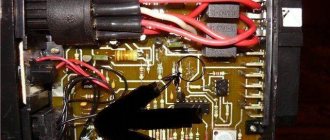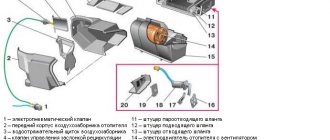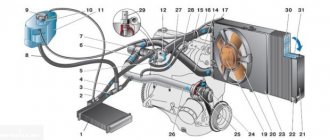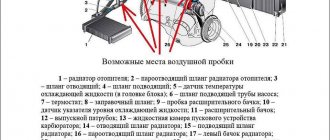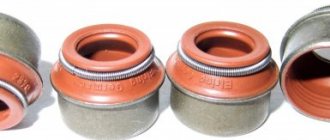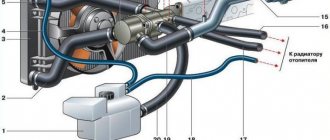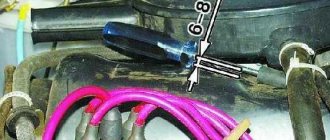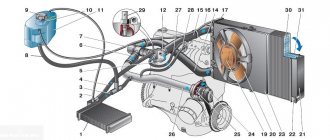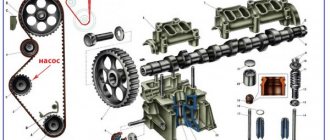Briefly about the design features of the stove on the VAZ-2112
Until the owner of a VAZ-2112 encounters a cold interior in winter, he may not realize that the stove of the entire tenth family has an important design feature - it is made in the form of two separate systems, in each of which a breakdown may occur or a design defect may appear. or a factory defect.
Heater design diagram.
- Firstly, the tens heater consists of an air heating unit itself. Everyone is familiar with this unit: heater radiator, air ducts with a regulation unit, cabin filter.
- Secondly, the car is equipped with an electronic temperature control system. Each of these elements can pose a potential threat to the microclimate in the cabin. Another element of the system is the heater control unit controller. We will check each of the elements, modify them if necessary, and bring the temperature in the cabin back to normal.
The device of the VAZ 2112 stove
Heater parts
- electro-pneumatic valve;
- front housing;
- water deflector;
- control valve;
- back of the case;
- radiator;
- radiator casing;
- lid;
- resistor;
- Electrical engine.
Heater ducts and controls
- Rear heating ducts.
- Plastic lining of the tunnel.
- Foot heating channels.
- Ventilation nozzles of the central part.
- Side nozzles.
- Heated front doors.
- Mechanical heating lever.
- Distributor housing.
- Damper for heating feet, windshield.
- Heater.
It is important to know. Differences in the design of the old and new VAZ 2112 in the shape of the heater radiator, the SAUO controller, and the micro-gearbox. Conventionally divided before 2004 and after. When purchasing, be careful not to hand over unnecessary parts.
From the above it follows that the heating system of the VAZ 2112 operates separately. The VAZ 2112 stove pumps air at the required temperature into the cabin. The pipes supply flow to heat the windshield, passengers' feet, and rear row of seats. Deformation of the dampers and deflectors creates an obstacle to the air flow, so the stove does not blow well and requires diagnostics.
Why is it impossible to change the heating temperature?
You can often observe a situation in the cabin 2110 2112 when the stove does not react in any way to the position of the temperature regulator, while the air temperature can be constantly low or constantly high. This is a sure sign that one of the electronic components has died. Let's check it all like this:
- Interior temperature sensor. The stove controller receives information from the temperature sensor. It is located on the ceiling, near the interior lamp. The sensor is guaranteed not to work if the stove responds to the temperature control knob set to the extreme right position. Otherwise, we are looking for a fault in the controller itself.
Temperature sensor location.
- Stove damper. The temperature may not change when the damper does not change its position. It is made of plastic, but its fastenings are metal, so they can oxidize, causing the damper to jam. Experienced owners recommend replacing the plastic damper with an aluminum one - it will dose air better and retain heat well. You can only get to the damper for inspection or replacement from under the hood.
Often the heater dampers get stuck.
- Damper actuator. The damper drive is a small gearbox and an electric motor. This whole structure often jams and the engine burns out. To check the functionality of the damper drive, you will have to remove the frill, wipers and insulation. The unit cannot be repaired and is replaced if it fails.
The cause of heater failure may be the damper drive.
Checking the dampers of the VAZ 2110 heater system
The stove system has 2 dampers. The upper one regulates the intake of cold air, and the lower one regulates the intake of hot air from the heater radiator. And when the drive mechanism or the damper itself breaks down, the stove can heat weakly, not heat at all, or fry too much.
Breakdowns of the stove damper can be of different types; firstly, the damper often gets stuck or jams, and secondly, the damper drive (micromotor-reducer) fails. In some cases, the damper warps or jams due to rust, since there are two types of dampers: the old and the new type, the old ones are plastic with a foam rubber seal, and the new one is metal with a rubber seal. Therefore, if you cannot hear the damper moving, you can move it by hand by removing the deflector in the central panel.
The problem with metal ones is that they often jam from rust, and plastic ones warp from exposure to hot air. So if, for example, warm air blows into the front window of a VAZ 2110, and hot air blows from the sides and into the legs, then most likely the damper has not completely blocked the air intake from the street. And when the dampers do not move at all, then you need to check the microdetector - the damper drive mechanism.
Weak supply of warm air, stove modernization
One of the main problems of the VAZ-2110 - 2112 heater is leakage and poor-quality assembly, poor quality of air duct elements.
The stove can wildly heat up the air entering it, but the barely perceptible warm breath of the heater can reach the cabin. It's all about leaky air duct connections, and, unfortunately, there are quite a lot of them. Firstly, it is recommended to seal the primary air ducts; a leak of heated air is often detected between them and the stove itself; it simply warms the engine shield.
Modernization of the heater for the driver’s feet, we will write a separate article about this. The photo shows our editorial car.
To eliminate this drawback, unfortunately, you will have to spend more than one hour, since it is impossible to get to the air ducts without dismantling the front panel.
It is necessary to check and seal each junction of plastic air ducts and their joints with the interior and glass air deflectors. Individuals who are particularly disappointed in the factory stove completely throw away the stock air ducts and replace them with corrugated hoses, which are abundant in hardware stores. The joints are sealed with polyurethane foam or modelin.
Of course, there is a lot of work, but the time spent is worth it - after modernization, absolutely all the warm air will flow only for its intended purpose.
Main malfunctions of the VAZ-2110 stove and their elimination
The heater in the VAZ-2110 car is represented by a separate system. Its first element is the heater itself - a unit responsible for preparing the incoming air. This device is located under the hood of the car. It regulates the air supply speed and its temperature. The next element is the air distributor, the air ducts of which are located inside the car on the dashboard. For tens, a special heater “2110-01” is produced, which is distinguished by the presence of an evaporator in the air conditioning system.
The heater control circuit for this VAZ model is shown in the photo:
Blowing cold air - inspection of the heater radiator and cooling system
The radiator of the VAZ-2110 stove also does not have high heat transfer, and besides, it is quite difficult to get to it. However, it may be associated with a weak interior heating temperature:
- The heater radiator is clogged. If antifreeze does not get into it when the cooling system is in full working order, then it will not heat. Diagnosing a clogged stove is difficult, but it is possible. With the engine fully warmed up and the heater on, we feel the temperature of the radiator inlet and outlet pipes by touch. If the inlet is hot and the outlet is cold, the heater radiator is clogged. Few people clean it; the public prefers to buy a new one. The market will allow you to choose several models of aluminum radiators and one or two copper ones at our discretion.
The problem of radiator obstruction is solved either by flushing using special liquids, or by replacing the element.
- Cabin filter. If the cabin filter is clogged, there is no need to talk about air supply to the cabin. We take out the filter, check its condition and change it if necessary. In winter you can do without it. Diagnostics is simple - if the temperature in the cabin returns to normal when the filter is removed, that is the problem.
It wouldn't hurt to check the cabin filter as well.
- Thermostat. Often there is a problem with the thermostat. Its valve refuses to allow antifreeze to flow into the heater circuit, so the radiator is left without liquid. The only cure is to replace the thermostat.
Checking the thermostat.
- Heater radiator leaking. A clear symptom of a malfunction is antifreeze in the cabin and a drop in the level in the expansion tank. Only replacing the heater radiator will help.
If the radiator leaks, you will have to dismantle it and replace it with a new one.
- Airlock. One of the most common problems with the cooling system and heater is an air lock. As a result, the circulation of antifreeze is disrupted and the stove does not warm up completely or does not heat up at all. The air plug is removed by releasing some of the liquid along with air from the very top of the engine - from the throttle block fitting while the engine is running. After removing the plug, the stove should restore functionality.
More rare faults
The cause of the breakdown may be the failure of other components of the car. Let's figure out what elements you will have to check and replace if necessary:
- Filling the ignition relay. With this malfunction, a previously broken fan may start working after 20-25 minutes of engine operation. This behavior of the unit is a sure sign that it does not work due to moisture getting inside the relay. Fixing this problem is simple - just replace the faulty unit. After this, the fan start will not be delayed.
- Blowing the interior with warm air only works at speed 3. In this case, it is necessary to check the condition of the additional resistor. If voltage is not supplied to the fan at speed 1 or 2, then this is most likely the problem. The resistor is located to the right of the stove behind the vacuum booster. To replace it you need:
- remove the negative terminal from the battery;
- in the cabin, remove the upholstery and windshield trim;
- remove the sound insulation from the right side of the car panel;
- remove the vacuum booster;
- disconnect the wire block from the converter;
- remember or mark how it was connected so that you can return it to its place correctly later;
- Check the resistor with an ohmmeter, if it is faulty, replace it and reassemble it.
- Broken heater switch. Sometimes the signal to turn on the stove simply does not reach the fan. In this case, you need to check this module:
- take a 12 V light bulb equipped with wires and disassemble the central console of the stove in the cabin;
- Connect the negative wire from this lamp to the body, and check all three contacts leading from the additional resistor to the switch with the connecting ones.
- if the light is on, then the switch is working properly, otherwise you need to replace the fuse in the mounting compartment and check the integrity of the wiring.
If after all the above tests and manipulations the fan still does not work, then the reason may lie in:
- electric motor of the device;
- contacts to the electric motor;
- motor brushes (they may stick to the main body or wear out).
As a rule, if replacing a fuse or resistor is not required (or does not help), then the fault should be looked for in the electric motor. You may need to replace the whole thing, clean the contacts, replace the brushes.
Trouble-shooting
Eliminating the inability to regulate temperature
There may be several reasons for this malfunction:
- malfunction of the control unit,
- damper malfunction.
Any of these breakdowns leads to incorrect operation of the heating device.
If the heater controller fails, the command to extend the damper may not be given. Therefore, you should immediately check the temperature sensor located next to the ceiling lamp. To check, you need to turn the temperature control lever several times from left to right. The temperature of the air flow can be controlled tactilely. This test is based on identifying the operating condition of the temperature sensor in the extreme position of the handle. If the flow temperature changes only when the sensor is in the extreme position, then it must be replaced. If it does not change significantly, you should look for the cause of the breakdown elsewhere.
Troubleshooting the heater
To check the functionality of the heater, you need to remove the central deflectors. To do this, you need to bend the special antennae and move the flap by hand. You can get to the latter through the engine compartment. When choosing this spare part, it is better to give preference to the aluminum rather than the plastic version. The radiator of the VAZ-2110 heater requires the largest amount of work when replacing it, because for this you have to remove the entire heater. If you do the work yourself, you can save a lot of money. Read more about how to change a radiator here.
Troubleshooting gearmotor
When the heater fan begins to “drive” only cold air, then we can assume that the heater has failed. In modern models, dampers and regulators rarely fail, due to the fact that aluminum is used for their manufacture at the factory. The gear motor is to blame for 90% of stove failures. This part definitely needs to be replaced.
In this case, car repairs are carried out in the following order:
- We dismantle the wipers, remove the frill,
- move the frill to the side, use a short Phillips screwdriver to unscrew the three fastening screws,
- unfasten the wires,
- connect a new gear motor,
- install it back.
It is better to perform this type of repair with an assistant. It will switch the air supply from hot to cold mode and back. After installation, the removed parts are reassembled in reverse order.
Elimination of poor flow of hot air into the area of the feet and side windows
This problem is very common in domestic cars. For this reason, in winter your feet get cold and your windows fog up. Driving a car in such conditions is very difficult. The only way out is to modernize the air flow channels.
The operating procedure is as follows:
1. Make sure that the stove is functioning perfectly. When its operation is ideal, you can begin modernization.
2. Remove the panel and disassemble it into its component parts.
3. Solving the problem of blowing side windows. This can be solved in two ways:
- We install a new corrugated hose.
- We seal all the cracks on the panel.
To improve efficiency, it is better to choose the second option. We continue to work.
4. We cover all the cracks between the bottom and top of the panel using anti-creak tape.
5. We glue all the holes that have fastenings.
6. We are modifying the heater dampers, which help direct air to certain areas. At the factory, this damper is poorly pressed to the body, because of this, part of the heated air is lost between the cracks and wanders somewhere in the panel.
7. We proceed to dismantling the damper. We remove it and completely remove the yellow factory seal.
8. We glue the valve with modelin and seal all the cracks. This procedure will help the air flow to ideally exit the damper as intended. On the body, instead of a sponge, it is better to use Bitoplast 10, which is diligently glued in several layers.
9. A lot of hot air is lost on the way to the driver's side window. This large gap needs to be sealed with mounting material. It will not creak while moving.
10. We are modernizing the air ducts leading to the feet of the front passengers. The block that distributes the warm flow to the feet has a huge gap that definitely needs to be sealed. For this purpose, the use of a corrugated tube is allowed.
11. We remove the completely standard air distributor from its original place, insert corrugations into all the resulting holes and fill everything with foam. The diameter of the pipe used must be exactly 40 mm.
12. It turns out that corrugations will be installed: one for the passenger’s feet, another for the driver, and a third for the rear passengers’ feet. We install all this in place and connect it.
Troubleshooting poor air heating by the stove
In this case, you can modify some elements of the stove:
1. Replace the heater damper with an aluminum one. This will help retain heat and prevent fragments from deforming.
2. Replace the heater installed on the model:
- “2112-01” – does not have a filter for air purification.
- “2112-02” - equipped with such a filter, but does not have an air recirculation function.
These filters can withstand a mileage of 15 thousand kilometers.
3. Install pre-heaters that will help warm up the engine and interior of the car even faster.
For more significant damage, the stove may need to be replaced. Most often, the replacement is made when tuning a VAZ 2110 with your own hands.
You can see in the video how to remove the VAZ-2110 stove and replace it.
